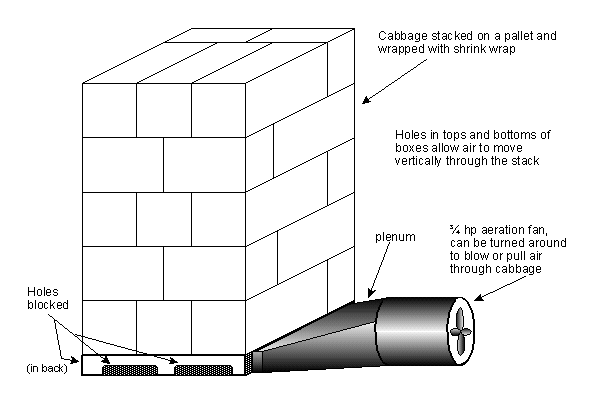
Oakes Irrigation Research
Site
Carrington Research Extension Center * North Dakota State University
P.O. Box 531, Oakes, ND 58474-0531, Voice: (701) 742-2189, FAX: (701)
742-2700, email: rgreenla@ndsuext.nodak.edu
CABBAGE COOLING
- A LOWER COST METHOD
Richard Greenland and Leonard Besemann
Figure 4. Schematic diagram of system used to cool cabbage.
To retain good quality cabbage, the cabbage must be cooled immediately after harvest. We looked at several coolers and found them all too expensive for our little operation. Most small producers would also find them too expensive. We decided to test a low-cost alternative. We rented a refrigerated semi-trailer and used it as a storage/cooling facility. Normally, placing boxed cabbage in a refrigerated trailer does not cool the cabbage quickly enough. Therefore, we set up a system to blow or pull air through cabbage stacked on a pallet. See Figure 4. Cabbage was harvested on August 12 and August 28. It was boxed in standard 1¾ bushel waxed cabbage boxes. These boxes were then stacked five layers high on a standard wood pallet. Air was blown or pulled through the cabbage for a day. Periodically during cooling, the system was shut off, the stack was partially disassembled, a head of cabbage was selected from the center of the stack, and its inside temperature measured. The stack was then reassembled and the system started again. The air in the refrigerated trailer was kept as close to 33F as possible during the time the cabbage was cooling. Results are given in Table 75.

Figure 4. Schematic diagram of system used to cool cabbage. This entire unit was placed inside a refrigerated trailer and it circulated the air from the trailer through the cabbage.
Return to top of cabbage cooling report.
Table 75. Results of cooling cabbage in a refrigerated trailer with no air movement, and with air being blown or pulled through the cabbage.
| Harvested August 12 | Harvested August 28 | |||
| Time after harvest | Blowing air through stack | No air movement | Time after harvest | Pulling air through stack |
| hours | temperature in F | hours | temp. in F | |
| 0 | 66 | 66 | 0 | 59 |
| 4.5 | 55 | 69 | 6 | 49 |
| 10 | 49 | 64 | 12 | 43 |
| 23 | 41 | 50 | 26 | 35 |
Cabbage temperature decreased faster when air was pulled or blown through the cabbage. It was much easier to pull air through the stack than to blow air through it. Pulling appeared to reduce cabbage temperature better (although the tests were not designed to directly compare pulling vs. blowing the air so we cannot be conclusive on this point). It is also reported that pulling air through cabbage dries the cabbage less than blowing air through cabbage. This was only a preliminary trial, but shows there is a good possibility of cooling cabbage this way. The equipment costs for this method are much less, but the efficiency is probably not as good, as with commercial coolers on the market. Additional modifications could speed up the cooling process and make it more efficient.
Return to top of cabbage cooling report.
Go to Oakes Irrigation Research Site 1998 annual report